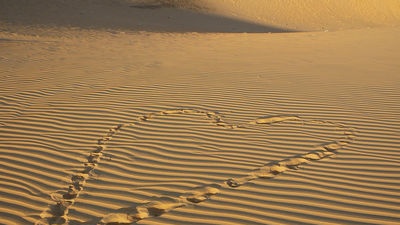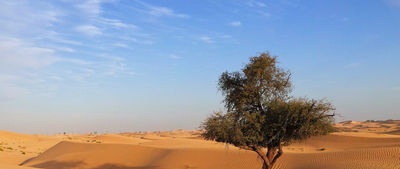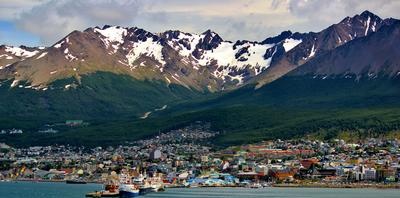|
 We are somehow used to imagining the desert as empty. Bare hills of sand, empty horizon, empty sky without a single cloud. And if there is something alive there, then there is little joy in it. Under the roots are scorpions with venomous, jointed tails, upturned like cocked cocks. We are somehow used to imagining the desert as empty. Bare hills of sand, empty horizon, empty sky without a single cloud. And if there is something alive there, then there is little joy in it. Under the roots are scorpions with venomous, jointed tails, upturned like cocked cocks.
Hairy phalanges with cadaveric venom on the jaws; black karakurt spiders, from the bite of which even hardy camels die. And there is nothing to say about snakes! The efa snake lives in the sands. In a rage, she rubs with the twists of her body, and her hard scales crackle and chirp at the same time, like butter in a hot frying pan. There is a white cross on the epha's head. Horses beat in agony from her bite. And gyurza! And the cobra!
Gyurza, with a head like a toad, crawls into houses and tents at night. And the beautiful cobra, although it does not have a pattern in the form of glasses on its neck, is no less poisonous than its famous Indian relative.
In general, the desert is a gloomy, boring and unsafe place. And, of course, in the desert you will suffocate from the heat or dry up like a mummy from lack of water.
I also imagined a desert like this. And, probably, that is why my first meeting with the desert was so unexpected for me. And it happened in the very center of our hottest desert - in Kara-Kum - Black Sands.
It turned out that the Black Sands are not black at all, but beautiful yellow, very clean and free-flowing, like water flowing through your fingers.
And on the very first day of my stay in this hottest and driest desert, I ... froze to the bone and got wet to the bone! Jets of rain whipped, the wind shook the gray saxaul bushes, the wet shirt stuck to the chilled body, and there was nowhere to hide.
Lightning flashed, thunder rumbled - and what thunder! - as if rumbling blocks of stones were falling from the sky. Black streams flowed along the road plump with dust, puddles swollen in the depressions. Wet to the skin, teeth chattering from the cold, I got into my sleeping bag and listened to the rain drumming on the tent all night.
Thus ended the first and unexpected day in the sands. Others crashed over the first day. A whole stream of surprises.
 The desert was not empty at all. It was April outside and flowers were blooming in the desert. The poppies were burning bright to the pain in their eyes. Delicate, as if molded from wax, white-pink eremurus blossomed. Rhubarb was turning yellow with leaves huge, like green umbrellas. Astragalus bushes were blooming purple. Kandym bushes were strewn with tiny white or pink flowers. Smells of fresh flowers floated over the dead sands: it smelled of roses, jasmine, and lilacs. The desert was not empty at all. It was April outside and flowers were blooming in the desert. The poppies were burning bright to the pain in their eyes. Delicate, as if molded from wax, white-pink eremurus blossomed. Rhubarb was turning yellow with leaves huge, like green umbrellas. Astragalus bushes were blooming purple. Kandym bushes were strewn with tiny white or pink flowers. Smells of fresh flowers floated over the dead sands: it smelled of roses, jasmine, and lilacs.
The tall stems of the desert broomrape, similar to minarets, laid out in mosaics, also bloomed with golden flowers. Above these amazing "minarets" flies, beetles and wasps rang and buzzed. The slender sandy acacia trees bloomed with dark purple flowers. The whole desert was blooming! There was no dull monotony and lifelessness around: everything was full of color, everything surprised and irresistibly attracted. Of course, the flourishing of the desert cannot be compared with the green riot of our forests and fields, but on the other hand, each plant, each animal attracted special and close attention, it was not lost among the mass of others, it did not merge into a common stream.
A sandy sedge turns green between the dunes. On the tips of thin green stems, brown hollow balls - fruit. When you step on them, they burst with a crash, and if sheep graze on a sediment, then such a crash over the flock stands, as if sheep are chewing crackers.
Or here is a desert tree - black saxaul. In some places it grows densely, it turns out something like a forest.
This tree is strange, and this forest is strange. In it, not only you cannot hide from the rain, but you cannot hide from the sun: there are no leaves on the saxaul, instead of green leaves there are green twigs.Therefore, in this forest there is no leaf fall, but branch fall does happen.
There is no better firewood than saxaul firewood! They burn with hot blue fire. Even freshly cut, raw ones catch fire from one match. However, saxaul is not cut with an ax. Do not saw it with a saw. Its wood is so strong that the ax bounces off, and so heavy that it sinks in water. The saxaul trees are tied with a steel cable and pulled out of the sand by tractors. And then at home, each owner simply hits a stone with a dry trunk, and the saxaul, which is difficult to ax and saw, is blown to pieces by the blow.
For the naturalist, surprise follows surprise. Well, who would have thought that such forest birds as ... woodpeckers live in the desert? And they also say that there is no gull without a sea, a lark without a field, a woodpecker without a forest! The Desert Woodpecker is very similar to our Great Spotted Woodpecker, only its wings appear white in flight. For this, they called him the white-winged woodpecker. He deftly climbs the saxaul, often jumps on the sand. Only he knows how he manages to hollow out hollows in the hard-stone saxaul. He also loves to play the "drum". But saxaul is really bad for a drum: the sound is muffled and quiet. Therefore, white-winged woodpeckers of the desert are very fond of drumming on the ringing telegraph poles that stand along the railways. And they are not even afraid of rumbling trains.
 I did not expect to see our bluethroats in the desert - birds that love dampness and shade. Graceful, slender, fast, with a blue crescent moon on their chest, bluethroats deftly dived under the saxauls and, clicking their beaks, grabbed insects. They were here temporarily, on the fly, but they also felt at home in a foreign land. I did not expect to see our bluethroats in the desert - birds that love dampness and shade. Graceful, slender, fast, with a blue crescent moon on their chest, bluethroats deftly dived under the saxauls and, clicking their beaks, grabbed insects. They were here temporarily, on the fly, but they also felt at home in a foreign land.
There were many of our acquaintances and fellow countrymen in the spring desert.
Under the bushes of saxaul, we caught ants of twirling necks. And the ants in the desert are cute! Phaetonica ants run with their belly lifted up to get less heat in the sun. The runner ants are such a color that they become invisible in the sand. And you can see them only in the morning and in the evening, when next to each invisible person his noticeable black shadow runs.
I met here our gray and small flycatchers. There were finches, black-headed chisels, red lentils on the way. All of them were guests in the desert, but they behaved confidently, like hosts.
I already began to get used to the unexpectedness of the desert, when one day, stepping out into the dunes, I suddenly heard ... the crowing of our cuckoo! A resident of dense forests was sitting on a bare dune and crowing! Even her footprints were imprinted on the sand: you will never see them in our forest.
After the cuckoo, I thought I wouldn’t be surprised at anything else. And he was surprised! Still: in the waterless desert I met ... a swamp heron! I have seen river kulichi. I saw the screamer dergach, an indispensable inhabitant of our wet meadows! The same guy who is said to be walking to Africa on foot. There is no need for him to go to Africa on foot, he has fast reliable wings, but to find a tiny, half-dried puddle in the huge desert - you need to be able to.
Where am I after all? Around there are woodpeckers, herons, Easter cakes and worm necks - just like in damp forests somewhere in the Leningrad region. And I am in Kara-Kumy, in the very center of dry Black Sands, in the southern and hot desert.
I hear a nightingale singing in the sands. I see crosses of wagtail tracks on the sand. And all this because now April is the time of the great flight of birds to the North.
People have always been amazed how these tiny birds do not get lost, do not get lost among the vast spaces. But you are especially amazed when you see what birds have to overcome: forest birds do without forests, aquatic birds without water.
Not only our old acquaintances turned out to be unexpected in the desert. Local, purely desert animals and plants also showed themselves from an unexpected side. Would I have believed anyone if I had not seen myself that desert lizards, for example, could die from ... sunstroke! And they, these children of hot sand and hot sun, at noon, if they could not hide in the shade, quickly lost their "consciousness" and died.And the mushrooms! Have you ever seen mushrooms grow on bare, hot, windy sand? Each time I looked at them in amazement. I don't know if they are edible or not, but if they are edible, then you can pick them directly dry, you just have to wait a little.
 Day after day, the usual ideas about the desert broke. No, the desert is not empty at all. And not only poisonous and terrible creatures inhabit it. The desert is a whole world, as changeable and mobile, as beautiful and fascinating as the forest, and the field, and the mountains, and the tundra. There were, of course, efuses, cobras, and gyurzes in the desert, there were phalanxes and scorpions. And it's very good that they were. All forms of life are interesting to the naturalist. But, besides them, many different harmless, amazing and simply cute creatures also ran, crawled and flew. Eyes raced to look at them. What was, for example, a skink nut-tip worth. He came out of his burrow at night, and his huge eyes shone like two rubies. If grains of sand adhered to his eyes, he rubbed his eyes with his own tongue! With excitement, he began to wag his tail, and at the same time his tail chirped like a grasshopper. If you grab it roughly, it will throw off its tail, and it will chirp in your hand, and the gecko that has lost its "voice" will try to sneak away. Day after day, the usual ideas about the desert broke. No, the desert is not empty at all. And not only poisonous and terrible creatures inhabit it. The desert is a whole world, as changeable and mobile, as beautiful and fascinating as the forest, and the field, and the mountains, and the tundra. There were, of course, efuses, cobras, and gyurzes in the desert, there were phalanxes and scorpions. And it's very good that they were. All forms of life are interesting to the naturalist. But, besides them, many different harmless, amazing and simply cute creatures also ran, crawled and flew. Eyes raced to look at them. What was, for example, a skink nut-tip worth. He came out of his burrow at night, and his huge eyes shone like two rubies. If grains of sand adhered to his eyes, he rubbed his eyes with his own tongue! With excitement, he began to wag his tail, and at the same time his tail chirped like a grasshopper. If you grab it roughly, it will throw off its tail, and it will chirp in your hand, and the gecko that has lost its "voice" will try to sneak away.
There are surprises at every turn. The fastest in the desert was not a wild donkey - a kulan, as was believed, but ... a tiny lizard - a sandy round-head: in one second it could run two meters, which is forty times longer than itself. If the kulan could run as fast, it would run 360 kilometers in an hour!
And the most sensitive one in the desert ... is a tick: it runs across the sand to a person five meters away. If the desert lynx - the caracal - had the same subtle instinct, then it would smell a person one and a half kilometers away!
The most sleepy one in the desert is the common turtle. She can sleep nine months a year without waking up. And at the same time, he does not lose much weight. And the most voracious in the desert is a tiny animal, the shittorak: during the night it eats beetles six times its weight. If the wolf of the desert were as gluttonous, he would eat a cow a day!
A brave lizard "red ears" lives in the desert. If she stubbornly pursues her, she rushes, sometimes, even at a person, although she cannot do him any harm. And the desert cricket lives, so shy and timid that even the beat of your heart scares him.
And the amazing animals are jerboas! Kangaroo feet, mouse body, hare ears and lion's tail!
Can you name all the extraordinary and unexpected. They are at every turn! Thorny, like coiled hedgehogs, bushes appear. .. a bindweed! Dead bushes, rough, bristling with thorns, like rusty skeins of barbed wire, suddenly bloom with the most delicate pink flowers!
You walk and peer, listen attentively, ponder. The sun burns mercilessly. The mouth is dry and bitter. The heart pushes with difficulty the thickened blood. Feet burns through the soles. After all, this is still a desert! Southern, hot - Kara-Kum ...
N. Sladkov
|
 We are somehow used to imagining the desert as empty. Bare hills of sand, empty horizon, empty sky without a single cloud. And if there is something alive there, then there is little joy in it. Under the roots are scorpions with venomous, jointed tails, upturned like cocked cocks.
We are somehow used to imagining the desert as empty. Bare hills of sand, empty horizon, empty sky without a single cloud. And if there is something alive there, then there is little joy in it. Under the roots are scorpions with venomous, jointed tails, upturned like cocked cocks. The desert was not empty at all. It was April outside and flowers were blooming in the desert. The poppies were burning bright to the pain in their eyes. Delicate, as if molded from wax, white-pink eremurus blossomed. Rhubarb was turning yellow with leaves huge, like green umbrellas. Astragalus bushes were blooming purple. Kandym bushes were strewn with tiny white or pink flowers. Smells of fresh flowers floated over the dead sands: it smelled of roses, jasmine, and lilacs.
The desert was not empty at all. It was April outside and flowers were blooming in the desert. The poppies were burning bright to the pain in their eyes. Delicate, as if molded from wax, white-pink eremurus blossomed. Rhubarb was turning yellow with leaves huge, like green umbrellas. Astragalus bushes were blooming purple. Kandym bushes were strewn with tiny white or pink flowers. Smells of fresh flowers floated over the dead sands: it smelled of roses, jasmine, and lilacs. I did not expect to see our bluethroats in the desert - birds that love dampness and shade. Graceful, slender, fast, with a blue crescent moon on their chest, bluethroats deftly dived under the saxauls and, clicking their beaks, grabbed insects. They were here temporarily, on the fly, but they also felt at home in a foreign land.
I did not expect to see our bluethroats in the desert - birds that love dampness and shade. Graceful, slender, fast, with a blue crescent moon on their chest, bluethroats deftly dived under the saxauls and, clicking their beaks, grabbed insects. They were here temporarily, on the fly, but they also felt at home in a foreign land. Day after day, the usual ideas about the desert broke. No, the desert is not empty at all. And not only poisonous and terrible creatures inhabit it. The desert is a whole world, as changeable and mobile, as beautiful and fascinating as the forest, and the field, and the mountains, and the tundra. There were, of course, efuses, cobras, and gyurzes in the desert, there were phalanxes and scorpions. And it's very good that they were. All forms of life are interesting to the naturalist. But, besides them, many different harmless, amazing and simply cute creatures also ran, crawled and flew. Eyes raced to look at them. What was, for example, a skink nut-tip worth. He came out of his burrow at night, and his huge eyes shone like two rubies. If grains of sand adhered to his eyes, he rubbed his eyes with his own tongue! With excitement, he began to wag his tail, and at the same time his tail chirped like a grasshopper. If you grab it roughly, it will throw off its tail, and it will chirp in your hand, and the gecko that has lost its "voice" will try to sneak away.
Day after day, the usual ideas about the desert broke. No, the desert is not empty at all. And not only poisonous and terrible creatures inhabit it. The desert is a whole world, as changeable and mobile, as beautiful and fascinating as the forest, and the field, and the mountains, and the tundra. There were, of course, efuses, cobras, and gyurzes in the desert, there were phalanxes and scorpions. And it's very good that they were. All forms of life are interesting to the naturalist. But, besides them, many different harmless, amazing and simply cute creatures also ran, crawled and flew. Eyes raced to look at them. What was, for example, a skink nut-tip worth. He came out of his burrow at night, and his huge eyes shone like two rubies. If grains of sand adhered to his eyes, he rubbed his eyes with his own tongue! With excitement, he began to wag his tail, and at the same time his tail chirped like a grasshopper. If you grab it roughly, it will throw off its tail, and it will chirp in your hand, and the gecko that has lost its "voice" will try to sneak away.








